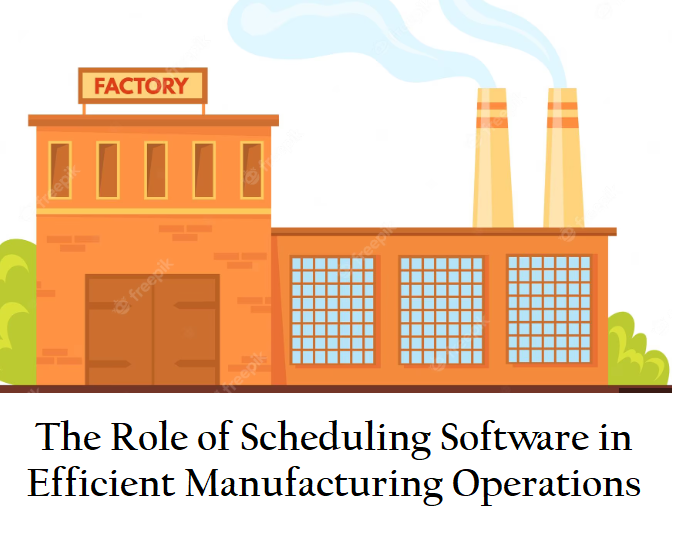The Role of ERP Scheduling Software in Efficient Manufacturing Operations
In the fast-paced world of modern manufacturing, the importance of efficient scheduling cannot be overstated. Manufacturers face a myriad of challenges, including meeting tight deadlines, optimizing resources, and responding to changing demands swiftly. To overcome these hurdles and enhance productivity, many manufacturers are turning to Enterprise Resource Planning (ERP) scheduling software. This article delves into the significance of ERP scheduling software in manufacturing operations, highlighting its benefits, various scheduling methods, common problems, and key considerations when selecting the right software.
Understanding ERP Scheduling Software for Manufacturing:
ERP scheduling software plays a pivotal role in the seamless orchestration of manufacturing processes. Its purpose is to create and manage production schedules that align with business goals, ensuring maximum efficiency and resource utilization. By integrating essential data from different departments such as inventory, production, and sales, ERP scheduling software enables real-time visibility and collaboration across the organization.
One of the primary benefits of ERP scheduling software is the optimization of scheduling processes. It automates and streamlines complex scheduling tasks, reducing the risk of human errors and minimizing downtime. Additionally, it empowers manufacturers to make data-driven decisions, enabling them to respond quickly to changes in demand, allocate resources effectively, and prioritize tasks efficiently.
ERP scheduling software tailored for manufacturing environments comes equipped with features specifically designed to enhance productivity. These include advanced forecasting capabilities, interactive Gantt charts, and real-time tracking of production status. These features allow manufacturers to forecast demand accurately, allocate resources optimally, and ensure timely completion of projects.
Different Scheduling Methods and Their Applications:
Manufacturing operations often employ various scheduling methods based on their specific needs and objectives. Three commonly used methods include First-In-First-Out (FIFO), Just-In-Time (JIT), and Material Requirements Planning (MRP).
FIFO is ideal for managing perishable or time-sensitive goods. It ensures that the oldest tasks are prioritized, reducing the risk of material waste and stock obsolescence. On the other hand, JIT focuses on delivering products precisely when they are needed, minimizing inventory holding costs, and promoting lean manufacturing principles. MRP, a more comprehensive approach, considers both demand and inventory levels to create efficient production schedules.
Each scheduling method has its merits, and manufacturers must carefully select the one that aligns with their operational needs. By implementing the right method, manufacturers can optimize resources, improve lead times, and respond proactively to market fluctuations.
Common Scheduling Problems in Manufacturing:
Despite the best efforts, scheduling in manufacturing can encounter a range of challenges. Conflicting priorities among tasks, machine breakdowns, and unexpected changes in customer demand are some of the common stumbling blocks manufacturers face.
Fortunately, ERP scheduling software provides effective solutions to address these issues. By offering real-time visibility and analytics, it enables manufacturers to reassign resources swiftly and accommodate priority changes. Moreover, automated alerts and notifications can help predict and prevent potential machine breakdowns, reducing downtime and increasing overall efficiency.
Selecting the Right Manufacturing Job Scheduling Software:
Choosing the right ERP scheduling software is crucial for seamless integration into existing manufacturing processes. Several factors need to be considered when making this decision. Key considerations include:
- Feature Set: Look for software with robust features like interactive Gantt charts, drag-and-drop functionality, and real-time updates. These features facilitate easy scheduling and enhance collaboration among teams.
- Integration: Ensure that the software can seamlessly integrate with other essential systems like inventory management and production planning software. A unified system promotes data accuracy and eliminates redundancies.
- Scalability: Opt for software that can grow alongside your business. Scalability is crucial for accommodating future expansion and increased production demands.
- Ease of Use: The software should have an intuitive user interface to streamline adoption and reduce training time for employees.
- Vendor Support: Choose a reputable vendor that offers excellent customer support and regular updates to keep the software up-to-date with evolving manufacturing trends.
Conclusion:
ERP scheduling software has become an indispensable tool for manufacturing operations seeking to optimize efficiency, reduce downtime, and enhance customer satisfaction. By centralizing data and automating scheduling processes, manufacturers can make well-informed decisions and respond rapidly to market changes.
As you embark on your journey to enhance manufacturing efficiency, consider exploring the capabilities of ERP scheduling software like the one we offer at LillyWorks. Their state-of-the-art software is designed to streamline your manufacturing operations, improve resource utilization, and boost productivity.
Contact us today to learn how our software can revolutionize your manufacturing processes and lead your business to greater success.
